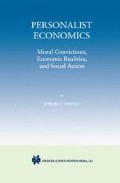Abstract
There are two ways to address the problem of defining and measuring unmet physical need. One is by demonstrated need, the other is by presumed need. By demonstrated need, a set of physical needs is defined beforehand and a person is determined to be needy (more or less) if he/she is able to demonstrate that his/her financial resources are inadequate to provide (more or less) for those needs. This method is used in the social-assistance form of direct aid to the needy, such as Aid to Families with Dependent Children, Medicaid, and Public Assistance. By presumed need, a person is presumed to be needy if a certain reasonably predictable life event occurs that is indicative of need such as becoming unemployed, being elderly and sick, or being orphaned. This method is used in social-insurance programs such as Unemployment Insurance, Medicare, and Survivors Insurance. Presumption scrutinizes personal and family financial circumstances less intrusively than demonstration.
... it will be necessary above all to abandon a mentality in which the poor — as individuals and as peoples — are considered a burden, as irksome intruders trying to consume what others have produced.
Centesimus Annus chapter 3.
Access this chapter
Tax calculation will be finalised at checkout
Purchases are for personal use only
Preview
Unable to display preview. Download preview PDF.
References
Congressional Budget Office. “Measuring Poverty,” Appendix A in Reducing Poverty Among ChildrenWashington, D.C: May 1985.
Final Report on Family Budgets: Cost Increases Slowed, Autumn 1981,“ Monthly Labor Review, July 1982.
Halladay, Allan. “The Significance of Poverty Definition to Australians”, Australian Journal of Social IssuesFebruary 1975.
Howard, Michael. “Poverty Lines in the 1980s: Rejection or Redevelopment”? Social Security JournalDecember 1982.
Korpi, Walter. “Approaches to the Study of Poverty in the United States: Critical Notes from a European Perspective,” in Poverty and Public Policy: An Evaluation of Social Science Research, edited by Vincent T. Covello, Cambridge: Schenkman Publishing Co, 1980.
Mack, Joanna and Stewart Lansley. Poor Britain, London: George Allen and Unwin, 1985. Marshall, Alfred. Principles of Economics, New York: The MacMillan Company, 1948.
Mayer, Susan E. Who is Poor: An Assessment of Income and Other Determinants of Material Well-Being, Ann Arbor: University Microfilms International, 1986.
Orshansky, Mollie. “Counting the Poor: Another Look at the Poverty Profile,” Social Security Bulletin January 1965.
The President’s Commission on Income Maintenance Programs. Poverty Amid Plenty: The American Paradox, Washington, D.C.: U.S. Government Printing Office, November 1969.
Ruggles, Patricia. Drawing the Line: Alternative Poverty Measures and Their Implications for Public Policy Washington: The Urban Institute Press, 1990.
Sawhill, Isabel V. “Poverty in the U.S.: Why Is It So Persistent?,” Journal of Economic LiteratureSeptember 1988.
Townsend, Peter. “Poverty as Relative Deprivation: Resources and Style of Living,” in Poverty, Inequality, and Class Structure, edited by Dorothy Wedderburn, London: Cambridge University Press, 1974.
Townsend, Peter Poverty in the United Kingdom: A Survey of Household Resources and Standards of Living, Berkeley: University of California Press, 1979.
U.S. Bureau of the Census. Current Population Reports, Series P-60, No. 155, Noncash Benefits: 1985, Washington, D.C., U.S. Government Printing Office, 1987.
U.S. Bureau of the Census. Current Population Reports, Series P-60, No. 163, Poverty in the United States: 1987, Washington, D.C.: U.S. Government Printing Office, 1989.
U.S. Bureau of the Census. Current Population Reports, Series P-60, No. 164-RD-1, Measuring the Effect of Benefits and Taxes on Income and Poverty: 1986, Washington, D.C.; U.S. Government Printing Office, 1988.
U.S. Bureau of the Census. Current Population Reports, Series P-60, No. 166, Money Income and Poverty Status in the United States: 1988. Washington, D.C.: U.S. Government Printing Office, 1989.
U.S. Bureau of the Census. Current Population Reports, Series P-70, No. 13, Who’s Helping Out? Support Networks Among American Families. Washington, D.C.: U.S. Government Printing Office, 1988.
U.S. Bureau of the Census. Current Population Reports, Series P-70, No. 14, Characteristics of Persons Receiving Benefits from Major Assistance Programs. Washington, D.C.: U.S. Government Printing Office, 1989.
U.S. Bureau of the Census. Current Population Reports, Series P-70, No. 15-RD-1, Transitions in Income and Poverty Status: 1984–85, Washington, D.C.: U.S. Government Printing Office, 1989.
Williams, Roberton. “Measuring Poverty with the SIPP and the CPS,” Washington, D.C.: U.S. Department of Commerce, Bureau of the Census, December 1987 (SIPP Working Paper No. 8723).
Zimbalist, Sidney E. “Recent British and American Poverty Trends: Conceptual and Policy Contrasts,” Social Service Review, September 1977.
Author information
Authors and Affiliations
Rights and permissions
Copyright information
© 1998 Springer Science+Business Media New York
About this chapter
Cite this chapter
O’Boyle, E.J. (1998). The Poor: Defined and Estimated in Terms of Subsistence Need and Economic Class. In: Personalist Economics. Springer, Boston, MA. https://doi.org/10.1007/978-1-4757-6167-2_9
Download citation
DOI: https://doi.org/10.1007/978-1-4757-6167-2_9
Publisher Name: Springer, Boston, MA
Print ISBN: 978-1-4419-5036-9
Online ISBN: 978-1-4757-6167-2
eBook Packages: Springer Book Archive

